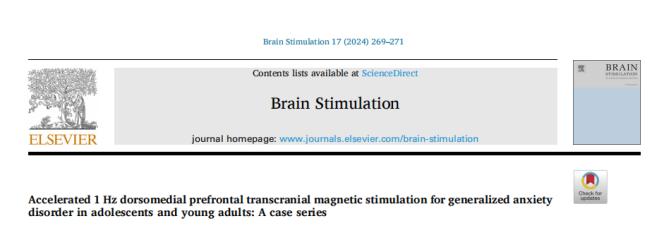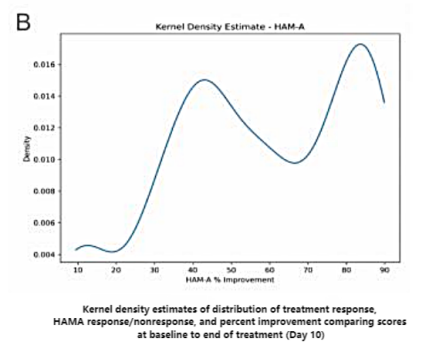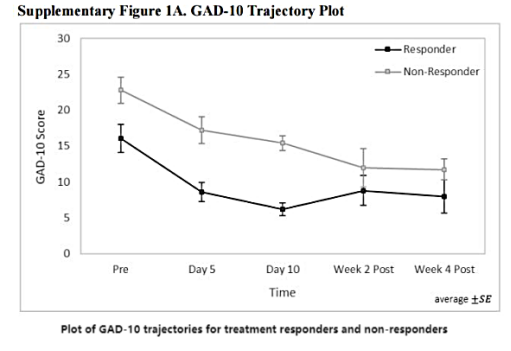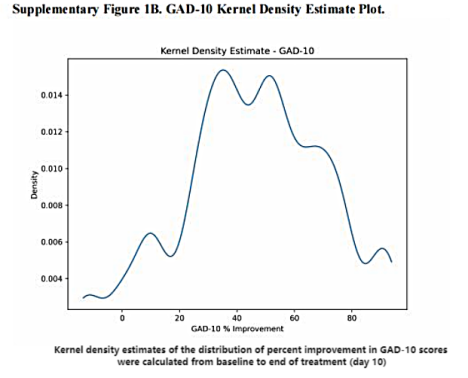Release time :2024-04-29
Source:support@yingchitech.com
Scan:867
Clinical Support Department of Shenzhen Yingchi Technology Co.,Ltd.
Generalized anxiety disorder (GAD) is one of the most common disorders affecting adolescents and young adults, with prevalence rates rising significantly over the past decade. Although psychotherapy and pharmacotherapy are often effective, more than 30% of patients remain clinically unresponsive to these interventions. Additionally, patients and caregivers are often reluctant to seek pharmacological treatment due to concerns about tolerance or possible worsening of suicidality. GAD not only affects the patient's life and social functions, but also often co-occurs with a variety of chronic diseases, such as cardiovascular and cerebrovascular diseases, diabetes, etc. GAD usually begins in childhood or adolescence, but can begin at any age. Most patients have symptoms throughout their lives and are worried and anxious for a long time. If not taken seriously, it can lead to severe depression and even suicide. Since the pathogenesis of GAD involves a complex interaction of multiple factors and treatments are limited, it is very important to find new treatments for GAD.
Transcranial Magnetic Stimulation (TMS) is a painless, non-invasive green treatment method that induces the cerebral cortex to generate induced currents through changing magnetic fields to directly regulate the activity of neurons and promote the remodeling of brain functional networks. In recent years, there has been growing evidence that transcranial magnetic stimulation can effectively improve anxiety, as well as its long-term role in treatment-resistant depression. In previous studies, the stimulation sites for TMS treatment of GAD were more concentrated in the dorsolateral prefrontal cortex, and other sites have not been involved. Recent fMRI studies have shown that anxiety symptom clusters have a unique target network, which is mainly concentrated in the dorsomedial prefrontal cortex (DMPFC) region. Regarding the optimal sequence for this population, low-frequency (1 Hz) TMS has advantages in terms of safety and tolerability, while having similar efficacy to other treatments for depression and anxiety and potentially superior effects on suicidality.
In this context, Mayo Clinic and Jonathan Downar's team in the Department of Psychiatry at the University of Toronto collaborated to investigate whether dorsomedial prefrontal accelerated low-frequency 1 Hz transcranial magnetic stimulation is safe and effective for the treatment of generalized anxiety disorder in adolescents and young adults. And related results “Accelerated 1 Hz dorsomedial prefrontal transcranial magnetic stimulation for generalized anxiety disorder in adolescents and young adults: A case series” is published in the journal Brain Stimulation (IF=7.7, March 2024).

A total of 26 patients aged 13-22 years old who were initially diagnosed with generalized anxiety disorder according to DSM-5 were included. 16 patients were adolescents aged 13-17 years old and 10 were young people aged 18-22 years old. An open-label study to investigate the safety, tolerability, and anxiolytic efficacy of accelerated low-frequency 1 Hz transcranial magnetic therapy in the right dorsomedial prefrontal cortex.

Main results: Clinically assessed Hamilton Anxiety Rating Scale (HAM-A)
Secondary results: 10-item generalized anxiety disorder severity in adolescents (GAD-10)
Supplementary results: 9-item Patient Health Questionnaire for Adolescents (PHQ-9) as a self-assessment of depression
Questionnaire assessments were conducted at baseline (days 0-5 before treatment), day 5 of treatment, day 10 of treatment, and weeks 2 and 4 after treatment.

Response occurred 13/26 (50.0%) on the 10th day of treatment and 13/26 (50.0%) at the 2nd week after treatment (HAM-A≤7). The results of follow-up at the fourth week6/12 (50.0%) after treatment met the remission criteria. Responses were reported on 18/26 (69.2%) at day 10 and 14/26 (53.9%) at week 2 after treatment (≥HAM-A 50% lower than baseline), and at week 4 after treatment, 9/12 (75.0%) patients met the response criteria. Overall, the HAM-A score improved from 19.5±SD7.0 at baseline to 7.9±SD4.4 on day 10 of treatment and 8.3±SD5.6 at week 2 after treatment.


On day 10 of treatment, 13/26 (50.0%) were in remission, and 16/26 (61.5%) were in remission at week 2 after treatment. On day 10 of treatment, the GAD-10 score improved from 18.7 ± SD7.6 at baseline to 9.7±SD5.




There were no significant differences in HAM-A or GAD-10 when comparing adolescents (13-17 years) and young adults (18-22 years) from baseline to day 10. In addition, differences in PHQ-9 scores were found between treatment responders and non-responders on day 10 of treatment, with responders showing significant remission on day 10 of treatment, it seems that treatment also improves symptoms of depression and suicidal tendencies.

Accelerated low-frequency 1 Hz transcranial magnetic stimulation of the right dorsomedial prefrontal lobe in adolescents/young adults with generalized anxiety disorder is safe and well-tolerated, with no patients withdrawing from the study due to tolerability issues; treatments were administered three times daily seems to have good compatibility with work/school schedules. The anti-anxiety effect was significant, with 50% of patients achieving relief after 10 days and 69% of patients reaching HAM-A response criteria. And the final supplemental results also appear to show that treatment has a positive impact on depression and suicidality in responders.
Studies also have limitations, such as lack of a control group, patient heterogeneity in comorbidities and prior treatment, possible failure of final results to capture important effects on comorbidities or functional outcomes, and lack of indirect outcome measures from relevant actors such as caregivers. Later, this can be addressed in a blind, randomized, pseudocontrolled design follow-up trial in which clinically meaningful effects are adequately detected in a larger sample of patients. The data of prospective research is indeed worth further exploring its potential research value, but it should also be considered from multiple aspects such as research design, research purpose and research execution in the future.
Overall, this is a prospective exploratory study that provides a potential new target for the treatment of generalized anxiety disorder in adolescents and young adults, and also provides a valuable new direction for the clinical diagnosis and treatment of mental illness.

1.This content is organized by the Clinical Support Department of Shenzhen Yingchi Technology Co.,Ltd. Criticisms and corrections are welcome. For reprint, please indicate the source.
2.Reference:
Croarkin, P. E., Dojnov, A., Middleton, V. J., Bowman, J., Kriske, J., Donachie, N., Siddiqi, S. H., & Downar, J. (2024). Accelerated 1 Hz dorsomedial prefrontal transcranial magnetic stimulation for generalized anxiety disorder in adolescents and young adults: A case series. Brain stimulation, 17(2), 269–271. Advance online publication. https://doi.org/10.1016/j.brs.2024.02.018